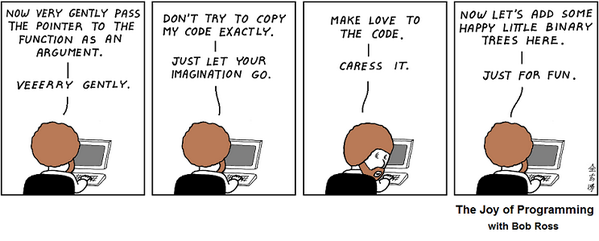name: bidirectional class: cols, middle, main .fifty.main-left[ # Interactive Front-end Development by Artem Halas and Stanislav Deviatykh ] .fifty.main-right[.main-circle[].secondary-circle[]] ??? Presenter display slide notes Pre-lecture checklist * Switching between mirroring and non-mirroring works * Unrelated tabs and windows closed or minimized * Do not disturb mode **ON** * Slides cloned, one has presenters mode on * Dependencies installed and scripts are working for lecture example code * Terminal(s) open with code and window to run scripts --- # Evaluating libraries/frameworks * What are the basic abstractions? * How well do they **compose**? --- # React & Reducers * Stateless React components * compose trivially through containment * **no state**, no _gotchas_, no complexity * Reducers * **Pure functions** compose whichever way you want --- # React & Reducers * New abstractions or small helper functions are easy to use because the core abstractions are pure functions ```js (props) => pseudoHtml ``` ```js (action, previousState) => newState ``` --- # Why all this functional programming nonsense? Can’t I just hack things together? --- # Why all this functional programming nonsense? * It **is not difficult** to hack together a prototype * It **is difficult** to build maintainable software --- # Communication with remote servers * HTTP APIs can be consumed in browsers via `fetch` * `fetch` is **unidirectional**, a server cannot make a request to the browser * e.g. _You have one new message_ * Some web applications require **bidirectional** communication to push updates to the browser --- # Long polling * HTTP requests can be hacked to achieve bidirectional communication * [https://en.wikipedia.org/wiki/Push_technology#Long_polling](https://en.wikipedia.org/wiki/Push_technology#Long_polling) --- # Long polling * Client sends request to Server * Server does not respond immediately and keeps connection open * When the server has information to _push_ to the Client, the Server sends a response to the open connection * Client receives response from Server containing the pushed information * Client immediately sends a new request to Server * Rinse and repeat, connection kept open until user on page --- # Long polling <figure> <img src="./assets/lecture-6/long-polling.png" alt="Long polling" style="width:100%"> <figcaption>https://javascript.info/long-polling</figcaption> </figure> --- # WebSockets * All modern Web Browsers support [WebSockets](https://developer.mozilla.org/en-US/docs/Web/API/WebSocket) which is a saner alternative * Note that simply polling (requesting data at an interval) is a valid simplification for many applications --- # WebSockets * `connection.onopen = callback` connection between Client and Server is established * `connection.onclose = callback` connection is closed by Server or Client or when connection is disrupted * `connection.onmessage = callback` Client received messages pushed from Server --- # WebSockets * `connection.send(utf8String)` send string-type message to Server (binary messages also supported) * `connection.close()` close connection from Client --- # Websockets * Websockets (and web requests) are an epitome of mutable state. * You never know **what**, **if** and **when** is coming from them. * Put them under tight supervision, **do not** leak them all over our beautiful application code --- # Code example [WebSocket example app](https://github.com/urmastalimaa/interactive-frontend-development/tree/master/lecture_6) --- # Testing WebSockets * WebSocket connections are initiated using the WebSocket global * WebSocket connections are inherently stateful * All this make testing WebSockets directly rather inconvenient --- # Testing WebSockets Some libraries provide mock implementations of WebSocket global ([https://github.com/thoov/mock-socket](https://github.com/thoov/mock-socket)) But generally, it is simplest to * avoid depending on intimate details of the WebSocket interface * provide a mock using simple "stub" functions [WebSocket example app test](https://github.com/urmastalimaa/interactive-frontend-development/tree/master/lecture_6/test/AppTest.js) --- # Distributed systems This is not a course on distributed systems, but... .full-image[] --- # Distributed systems From the moment a remote Server is introduced, a distributed system is created In a distributed system it is important to understand * who **owns** (modifies and can be queried for) what information * how updates are broadcasted / subscribed to * what are the message delivery guarantees of communication channels --- # Distributed systems It is **very easy** to create an inconsistent system Difficulting in retaining consistency increases when more moving parts are added to a system (e.g multiple processes for load balancing/resiliency) --- # Distributed systems Before using any technology that can be _connected_ to * HTTP requests, * WebSockets, * (NoSQL, relational) databases, * etc understand message **delivery and consistency guarantees** --- # WebSocket delivery guarantees * WebSockets use a single TCP connection, * messages are guaranteed to arrive **in-order** and **exactly-once** * as long as the connection is alive * [https://tools.ietf.org/html/rfc6455](https://tools.ietf.org/html/rfc6455) **As long as the connection is alive** ??? In practice connections are arbitrarily closed all the time --- # Object updates with WebSockets _Word of caution from personal experience_ When pushing updates about large objects (collections) it seems to be a good idea to send _partial updates_ instead of whole objects --- # Object updates with WebSockets When integer set changes 1. {1,2,3} 2. {1,2,3,4} 3. {1,3,4} Server sends 1. Initial: {1,2,3} 2. Add 4 3. REMOVE 2 --- # Object updates with WebSockets * As message order is guaranteed, such updates can be used to maintain the set -- **Unless** * Update handler encounters unexpected error client side * Server encounters error sending update --- # Object updates with WebSockets **Unless** * Connection drops and server doesn't re-send the whole object * Connection drops and server starts loading the whole object (from database), but an update comes in just before it finishes and the client ends up missing the update If anything fails, the maintained object is inconsistent **until user reconnects (refreshes)** --- # Object updates with WebSockets * The message order guarantee is only for a single WebSocket connection * This needs to be considered when building any protocol on top of WebSockets * Try to use something that is battle-tested instead of homebrewing complex protocols on top of the low level WebSocket API * Or just send full state objects as long as you can... --- # WebSocket request-response? * WebSocket is a low level protocol * It does not have request - response semantics * It barely has any semantics at all. * If you need it, don’t try to build it yourself * [http://wamp-proto.org/](http://wamp-proto.org/) * [https://www.npmjs.com/package/json-rpc2](https://www.npmjs.com/package/json-rpc2) --- # Homework [Requirements](https://github.com/urmastalimaa/interactive-frontend-development/blob/master/homework/weather/exercise6.md) * Deadline 01/05/2022 23:59 * Submit zipped file to https://courses.cs.ut.ee/2022/react/Main/Submit * Tests will give significant points * **Only submit what is yours** --- <video width="100%" height="50%" controls> <source src="assets/lecture-6/hw-6.mov" type="video/mp4"> Your browser does not support the video tag. </video> --- .full-image[] .footer[Courtesy of https://twitter.com/onquality/status/436608223240802304]